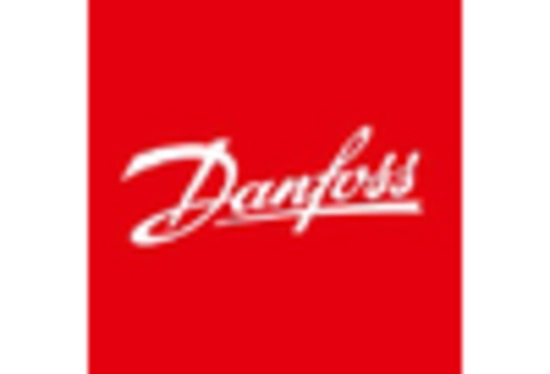Advancements in Technology
Technological advancements play a pivotal role in the evolution of the Hydronic Underfloor Heating Market. Innovations such as smart thermostats and automated control systems enhance the efficiency and user-friendliness of hydronic heating systems. These technologies allow for precise temperature control and integration with home automation systems, appealing to tech-savvy consumers. The market is projected to grow as these advancements become more prevalent, with estimates suggesting a compound annual growth rate of around 8% over the next five years. This trend indicates a strong potential for the Hydronic Underfloor Heating Market to expand as technology continues to evolve.
Growing Construction Sector
The expansion of the construction sector significantly influences the Hydronic Underfloor Heating Market. As new residential and commercial buildings are constructed, there is an increasing preference for modern heating solutions that offer comfort and efficiency. Hydronic underfloor heating systems are often favored in new builds due to their ability to provide even heat distribution and compatibility with various flooring types. According to industry reports, the construction sector is expected to grow at a rate of 5% annually, which bodes well for the adoption of hydronic systems. This growth in construction directly correlates with the rising demand for the Hydronic Underfloor Heating Market.
Environmental Regulations and Standards
The Hydronic Underfloor Heating Market is also shaped by stringent environmental regulations and standards aimed at reducing carbon footprints. Governments worldwide are implementing policies that encourage the use of renewable energy sources and energy-efficient technologies in heating systems. Hydronic heating systems, which can be powered by renewable energy sources such as solar or geothermal, align well with these regulations. As a result, the market is likely to see increased adoption as builders and homeowners seek to comply with these standards. This regulatory environment creates a favorable landscape for the Hydronic Underfloor Heating Market to thrive.
Rising Demand for Energy-Efficient Solutions
The Hydronic Underfloor Heating Market is experiencing a notable surge in demand for energy-efficient heating solutions. As consumers become increasingly aware of energy consumption and its environmental impact, they are seeking alternatives that reduce energy costs while maintaining comfort. Hydronic systems, which utilize water as a heat transfer medium, are recognized for their efficiency, often achieving energy savings of up to 30% compared to traditional heating methods. This shift towards energy-efficient solutions is further supported by government incentives and regulations promoting sustainable practices, thereby driving growth in the Hydronic Underfloor Heating Market.
Consumer Preference for Comfort and Aesthetics
Consumer preferences are evolving towards heating solutions that not only provide comfort but also enhance the aesthetic appeal of living spaces. The Hydronic Underfloor Heating Market benefits from this trend, as underfloor heating systems are invisible and do not disrupt interior design. Homeowners appreciate the comfort of warm floors, especially in colder climates, and the ability to maintain a clean and uncluttered space. Market Research Future indicates that a significant percentage of consumers prioritize comfort and aesthetics when selecting heating systems, suggesting a robust potential for growth in the Hydronic Underfloor Heating Market as these preferences continue to shape purchasing decisions.


















Leave a Comment